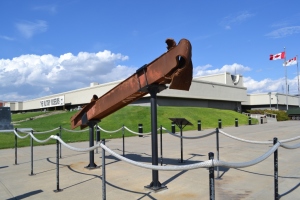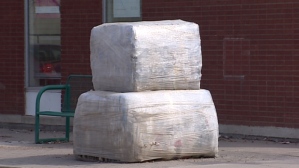Tomorrow, (May 21) the National September 11 Memorial & Museum opens to the public.
As to be expected with a grand-opening in remembrance to a moment in time that has defined and will continue to leave a lasting imprint on our collective world-view at least for this generation, there has been increasing amount of coverage in various media outlets about this event and museum.
This of course reminded me that own Military Museums has an artefact from the World Trade Centre housed outside the front doors to the museum.
Before I get going, I must state right up front that there are two main opposing viewpoints surrounding the events that took place in New York City on the morning of Monday, September 11th, 2001. I choose not to speculate on something I know little, but I will summarize.
-
There is the officially-sanctioned story that two airplanes were hijacked and flown into the World Trade Centre.
-
With an event of this magnitude, and because the human mind is highly adept and continually tries to make sense of chaos, there is at least one major conspiracy theory which is contrary to the accepted story.
As stated previously, I choose not to discuss any possibility of what happened that fateful day. Rather, I prefer to talk about the Calgary artefact itself.
In the time leading up to the installation, a friend of mine was a curator at The Military Museums on secondment from the University of Calgary. This was a time when we would cross paths often, as we were working on a curatorial project together, so I would hear about the progress of this artefact and how it ended up in Calgary.
I was far enough away that I would only hear bits and pieces periodically. I was definitely not involved in the minutiae involved in this project. However, I was definitely interested in the process and progress.
Somewhere along the way, someone involved at The Military Museums found out that some of the artefacts from the World Trade Centre attack were available for donation in appropriate museums or settings by the Port Authority of New York and New Jersey. As I recall most of those were placed in the USA. Regardless of where they all ended up, it was a long process to get the work here. If I recall correctly it was probably at least a year, possibly a two or three year project as there was a number of logistical challenges along the way. From my perspective, this was not overly surprising.
In addition, there was a fundraising component of some sort that The Military Museums initiated leading up to the installation. From what I understand, this was for the design, engineering and feasibility studies and other related expenses to safely suspend the 15 foot, 1270 kilogram twisted steel structural beam.
This tribute was unveiled at its present location, on the tenth anniversary of the World Trade Centre attack on September 11, 2011.
Reading the New York Post this past weekend and my visit to the TMM this afternoon, it is thought-provoking to observe the differences between the two museums and how they have commoditised (or not commoditised) the 9/11 event.
The related issue of how museums survive and funding of them is a topic for another day – if I ever get around to it on this blog. It is a very complex issue with all sorts of tangled macro- and micro-political sentiments and theory involved. Quite frankly a blog might not be the right forum for it.
I realize that on a certain level we are comparing apples and oranges, and from pictures I have seen in the Globe and Mail this past weekend, the 9/11 Memorial will no doubt be a very interesting tribute to those who died that day.
This New York Post story which I mentioned above, talks about the 9/11 gift shop, although there is a link to more about the museum inside the body of the article. Here, in Calgary, the 9/11 artefact stands alone as a silent sentinel which allows the viewer to bring their own memories of that day without even having to enter the museum to encounter it.
On edit (2014 May 30).
Further to what is stated above, I read a recent article which was posted on the Huffington Post by Robert Klitzman, M.D. whose sister died in the World Trade Centre attack, that a number of these steel girders are incorporated into the 9/11 Museum. However, that is not the reason for the edit. In the article Klitzman proposes that the museum could:
inspire us not only to remember the deceased — which it does well — but to ponder these broader issues more, adding to its narrative of victims and heroes, by exploring these larger contexts and dilemmas, broadening our understanding, and moving us to consider far more fully these larger questions about the nature of belief, religion, tolerance, evil and hatred, and ways of perhaps preventing such atrocities in the future. The exhibits would not be able to cover these these issues exhaustively, but could provide a unique and important opportunity to have us reflect on these larger questions. Doing so, could potentially help prevent future such attacks and promote peace, even if in small ways.
Just some food for thought. The issues he raised might have broader applications, than just at the 9/11 Museum.

